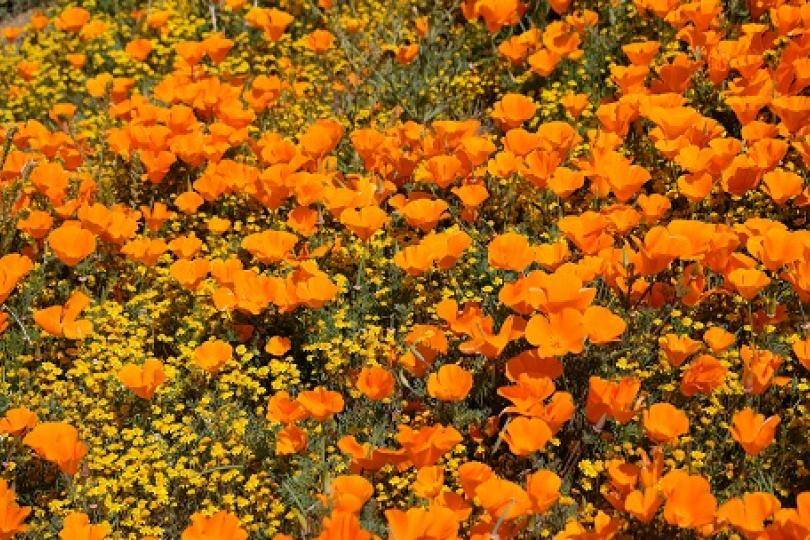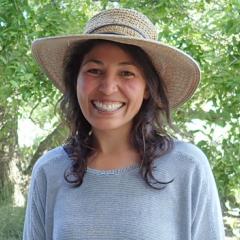Jensen, Fraga and Jesus quoted in Vogue: why California’s wildflowers are under siege
Editor's note: Switzer Fellows Nick Jensen, Naomi Fraga and Maria Jesus were featured in Vogue's Earth Day article Saving the Super Bloom: Why California’s Wildflowers Are Under Siege. Below is a selection of their quotes from the article. Read the original peice for the full story and stunning wildflower photographs.
Saving the Super Bloom: Why California’s Wildflowers Are Under Siege
One day earlier this spring, botanist Nick Jensen visited one of the few “super blooms'' in California following a bone dry winter across the state. Under a bluebird sky, he hiked among displays of wildflowers that popped like confetti in sweeping hues of orange, purple, pink, and yellow. Native species like California poppy, lupine, and purple owl’s clover overtook the volcanic landscape known as North Table Mountain and spritzed their sweet perfume across the cool afternoon.
Jensen wasn’t alone—the rare spectacle had drawn thousands of people to the ecological reserve only an hour outside of Sacramento. In true super bloom fashion, visitors brought selfie sticks, sundresses, and wide brimmed hats, posing among the vast fields of color. Some crushed the very flowers they came to see.
Much of California this spring, however, remained parched and brown. Locations popular for their exceptional wildflower blooms like Anza Borrego Desert State Park—that drew crowds the size of Coachella in 2017 and 2019—produced small, modest wildflower displays. Other popular locations in Southern California like Death Valley National Park, Antelope Valley California Poppy Reserve, Carrizo Plain National Monument, and Walker Canyon were mostly devoid of wildflowers.
“Nothing is guaranteed on any given year,” says Jensen, the conservation program director of the California Native Plant Society. “For an exceptional year, you need a fair amount of rain that is spread out over a significant period of time from the late fall to early spring.” He notes that the phenomenon is multifactorial and that scientists still can’t exactly predict when large scale blooms will occur—adding to the mystique of the displays. While the magnificent blooms vary by region in California, they typically happen about once a decade. Native wildflowers provide critical habitat for pollinators, improve soil health, help prevent erosion, and promote healthy ecosystems.
...
But despite their popularity and ecological importance, wildflower blooms across California and the greater Southwest are in peril due to a pile-on of human-caused stressors including invasive plants, residential and green development, agriculture, mining, and climate change. “We have lost a significant portion of wildflower habitat in such a short period of time,” Jensen says. “This phenomenon, which seems so rare and so special—because it is so rare and special—might not have been that uncommon in the past.”
...
“We can’t afford to consider losing even a single additional acre of wildflower habitat,” says Jensen, mentioning numerous developments putting wildflower environments at risk across the state. One of these projects, Centennial, plans to construct a town of 19,000 units in a remote region in the northwest corner of Los Angeles County on a parcel of land that explodes in a kaleidoscopic super bloom, like a Monet painting on steroids. The project, led by Tejon Ranch Co., has been in development since 2002, but last month it was temporarily halted by a Los Angeles Superior Court judge after cases were filed—one by The California Native Plant Society and the Center for Biological Diversity, and a second by Climate Resolve.
The company claims the development is essential due to a housing crisis in Los Angeles County, but advocates opposing the project say it’s in a dangerous wildfire zone, will increase greenhouse gas emissions, and will erase one of the few remaining spaces of wildflower habitat in California. “Californians shouldn’t have to choose between irreplaceable habitats and affordable housing,” Jensen says.
...
Across the Mojave Desert, other projects threaten thousands of acres of habitat on public land managed by the Bureau of Land Management. As a multi-use land agency, the BLM oversees mining and other resource extraction projects, as well as green energy projects like solar and wind farms. “Over my time as a botanist, I’ve witnessed the solar industrialization of thousands, if not hundreds of thousands of acres in the desert,” says Naomi Fraga, director of conservation at California Botanic Garden. “Most people might not think about how industrial scale solar is impacting super blooms,” she says.
While environmental groups agree on the need for green energy, many argue that carbon-sequestering desert environments shouldn’t be used for large-scale solar farms or wind farms. Non-profit groups like Basin and Range Watch argue for integrating solar in urban centers, covering large swaths of already developed land like parking lots and warehouses. A recent study in Nature showed that if California covered all 4,000 miles of its canals with solar panels, they would save over 63 billion gallons of water from evaporation and produce 13 gigawatts of renewable power every year. Still, projects like the Yellow Pine Solar Project in Nevada plan to bulldoze over 3,000 acres of pristine desert habitat to install a large-scale solar farm, projected to destroy over 90,000 Mojave yuccas, as well as habitat for the endangered desert tortoise.
“People often think of deserts as these desolate landscapes that only come to life when there’s rain,” Fraga says. “But life is always present, it’s just in the form of seeds.”
...
Towering in the Mojave Desert between the Sierra Nevada and the mountains of Death Valley National Park is Conglomerate Mesa, a rugged ridge part of California’s remote Inyo Mountains. Near the transition zone of the Mojave and Great Basin Deserts, the flat-topped mountain holds a rich biodiversity of flora that desert botanist Maria Jesus has spent the past two years surveying. “In 2019, there was a whole sea of rock and sand that transformed into colorful blooms,” says Jesus. “There tends to be super bloom events in the lower elevations [of the mesa] but in the higher elevations you get more reliable, sparse blooms.”
...
“Even though there’s not a super bloom every year, there's always something to appreciate at a smaller scale,” says Naomi Fraga. “It helps us better understand the grandeur of these incredible, impressive displays as wildflowers—and reminds us that there's a lot happening underground.”



